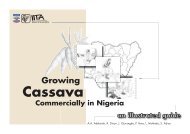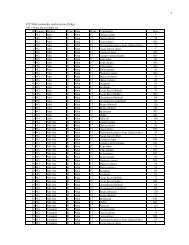Growing Citrus in Nigeria Growing Citrus - Cassavabiz.org
Growing Citrus in Nigeria Growing Citrus - Cassavabiz.org
Growing Citrus in Nigeria Growing Citrus - Cassavabiz.org
Create successful ePaper yourself
Turn your PDF publications into a flip-book with our unique Google optimized e-Paper software.
COMMERCIAL CROP PRODUCTION GUIDE SERIES<br />
<strong>Grow<strong>in</strong>g</strong> <strong>Citrus</strong><br />
<strong>in</strong> <strong>Nigeria</strong><br />
United States Agency for<br />
International Development<br />
www.usaid.gov<br />
Information and Communication<br />
Support for Agricultural<br />
Growth <strong>in</strong> <strong>Nigeria</strong><br />
www.ics-nigeria.<strong>org</strong><br />
ICS-<strong>Nigeria</strong>
<strong>Grow<strong>in</strong>g</strong> <strong>Citrus</strong> <strong>in</strong> <strong>Nigeria</strong><br />
Site selection<br />
Sandy loam is best for the cultivation of <strong>Citrus</strong>. The most important factor <strong>in</strong><br />
the choice of site is free/dra<strong>in</strong>age of water. Soils with an underly<strong>in</strong>g hardpan<br />
of about 1m or less to the top mock soils, or sla<strong>in</strong> sites are not suitable. Apart<br />
from these, citrus can be grown on a wide range of soil types. <strong>Citrus</strong> is not<br />
shade lov<strong>in</strong>g, therefore clear the site of all tree stumps and plough before<br />
sett<strong>in</strong>g <strong>in</strong> the plants.<br />
Varieties<br />
<strong>Citrus</strong> consists of many species, some of which are not even edible. Some<br />
varieties of the edible ones have however been recommended to the public.<br />
These <strong>in</strong>clude:<br />
Species<br />
Recommended varieties<br />
Sweet Orange<br />
etc.<br />
grapefruit<br />
Tanger<strong>in</strong>e<br />
Tangelo(grapefruit<br />
x Tanger<strong>in</strong>e)<br />
Lemon<br />
Lime<br />
Propagation<br />
Haml<strong>in</strong>, Valencia, Agege Parson Brown,<br />
Durean, Marsh, Ruby Red, etc.<br />
Dancy, Algerian, Clement<strong>in</strong>e, etc.<br />
Lake, M<strong>in</strong>neola, etc.<br />
Lisbon, Eureka, etc.<br />
Key, West Indian,.<br />
<strong>Citrus</strong> is almost entirely propagated by budd<strong>in</strong>g. Plant only budd<strong>in</strong>g<br />
seedl<strong>in</strong>gs <strong>in</strong> orchards as unbudded seedl<strong>in</strong>gs may not be true-to-type, and<br />
often takes a long time to fruit. They are also susceptible to disease attack.<br />
Obta<strong>in</strong> budl<strong>in</strong>g by select<strong>in</strong>g a required bud and unit<strong>in</strong>g this with a suitable<br />
rootstock. Make sure the budl<strong>in</strong>gs are obta<strong>in</strong>ed from repured sources.<br />
Orchard establishment<br />
Plant the orchard when the ra<strong>in</strong>y season has fully set <strong>in</strong>. In the south this is<br />
around May, but about June <strong>in</strong> the north. Complete plant<strong>in</strong>g holes, well <strong>in</strong><br />
advance, before purchas<strong>in</strong>g the budl<strong>in</strong>g. These holes should be 25 cm x<br />
18 cm and 7 cm apart <strong>in</strong> either direction. Set the trees <strong>in</strong> these holes (which<br />
have been half–filled with rich topsoil) and shovel <strong>in</strong> back the soil firmly<br />
around the trees. Always ensure that the trees are planted no deeper than<br />
they had grown <strong>in</strong> the nursery.<br />
2
Orchard management<br />
WEED CONTROL<br />
Absolute weed control under a hot, humid climate may be very expensive,<br />
nevertheless there is need for some level of weed control. Slash the orchard<br />
at least 3 times <strong>in</strong> the year, the last be<strong>in</strong>g at the on-set of the dry season. In<br />
addition, r<strong>in</strong>g weed <strong>in</strong>dividual trees constantly. R<strong>in</strong>g-apply Diuron or Paracol<br />
to check weed growth.<br />
INSECT PEST CONTROL<br />
rich top-soil<br />
Holes dug 25 cm x 18 cm and 7 cm apart <strong>in</strong> either direction for citrus transplant.<br />
The control of <strong>in</strong>sect pests on citrus depends on the stage of development.<br />
Nursery pests are mostly leaf-eat<strong>in</strong>g <strong>in</strong>sects like caterpillars and plant ‘bud’.<br />
Control the caterpillar with Cymbush, Ambush, Decis or Sherpa plus at the<br />
rate of 0.9–1.00 Liters E.C. formulation <strong>in</strong> 300 Liters of water per hectare.<br />
The fruit fly, fruit pierc<strong>in</strong>g moth, and ‘bud’ control can be achieved through<br />
effective <strong>in</strong>tergrated approach with close supervision by experts.<br />
3
CONTROL OF FUNGAL DISEASES<br />
There are two major disease of citrus.<br />
A group affects leaves, stem and roots. The others are fruit diseases which<br />
Leaf-eat<strong>in</strong>g <strong>in</strong>sects<br />
Leaf-eat<strong>in</strong>g <strong>in</strong>sects like caterpillars could be controlled with, sherpa plus .<br />
orig<strong>in</strong>ate from the field and cont<strong>in</strong>ue at storage. Some of these diseases are<br />
twig or branch dieback, foot rot and Brown rot gummosis and blast. Control<br />
the fungal diseases by apply<strong>in</strong>g Benlare at 20 g/ 10 L water on the trees with<br />
any wett<strong>in</strong>g agent. You can curtail fruit anthracnose and Phytophthora rot by<br />
apply<strong>in</strong>g either Thiabendazone at 10 ml/ 10 L water or Benlare at 10 g/ 10L<br />
water. In case of Gummosis, Scab and Root rot attack, seek the advice of crop<br />
protection experts.<br />
Fertilizer application<br />
Do not apply any <strong>org</strong>anic fertilizer at plant<strong>in</strong>g or dur<strong>in</strong>g the 1 st year of plant<strong>in</strong>g<br />
<strong>in</strong> the orchard. Thereafter apply the follow<strong>in</strong>g recommendation <strong>in</strong> a shallow<br />
furrow around the trees (correspond<strong>in</strong>g to the drip-marg<strong>in</strong> of the canopy).<br />
(a)<br />
2–4 years of age:<br />
500 grams of compound fertilizer N.P.K (15:15:15) per trees, twice<br />
<strong>in</strong> the year.<br />
(b)<br />
5–10 years of age:<br />
2 kg (15:15:15) + 600 grams k 2<br />
0 per tree, twice <strong>in</strong> the year.<br />
4
(c ) 10 years and above: 3 kg (15:15:15) + 800 grams k 2<br />
0 per tree,<br />
twice <strong>in</strong> the year.<br />
These applications should be done <strong>in</strong> June and September to obta<strong>in</strong> maximum<br />
benefit.<br />
Irrigation<br />
<strong>Citrus</strong> trees will wilt and yield will be depressed unless moisture is provided<br />
dur<strong>in</strong>g the long dry season of November to February. Therefore, make sure<br />
that the trees are watered dur<strong>in</strong>g this period. Ten liters of water (stream<br />
Deliver water at the base of the trees twice a week .<br />
water, well water, tap water, etc.) delivered at the base of the trees twice a<br />
week is sufficient for good development and yield.<br />
Intercropp<strong>in</strong>g citrus with selected field crops<br />
Spac<strong>in</strong>g of citrus (7 m x 7 m) is relatively wide and allows for considerable<br />
land to rema<strong>in</strong> unproductive for some years while no <strong>in</strong>come is obta<strong>in</strong>ed<br />
from citrus. At least for the first 3 years before citrus trees start fruit<strong>in</strong>g the<br />
wide <strong>in</strong>ter-row spaces can be cropped to compatible field crops such as p<strong>in</strong>eapple,<br />
water melon, egusi melon, cowpeas, okro, soya, sweet potato etc.<br />
The recommended doses of fertilizer dress<strong>in</strong>g for each of these crops should<br />
5
e used. Adopt effective pest/disease management. This practice maximizes<br />
land utilization, controls to farmers before citrus trees start fruit<strong>in</strong>g.<br />
The <strong>in</strong>formation for this Production Guide was obta<strong>in</strong>ed aafrom Extension Research<br />
Liaison and Tra<strong>in</strong><strong>in</strong>g Unit<br />
National Horticultural Research Institute (NIHORT)<br />
P M B 5432,<br />
Idi - Ish<strong>in</strong>, Ibadan.<br />
6
About ICS-<strong>Nigeria</strong><br />
Information and Communication Support for Agricultural Growth <strong>in</strong><br />
<strong>Nigeria</strong> (ICS-<strong>Nigeria</strong>) is a project which aims to <strong>in</strong>crease the quantity and quality<br />
of <strong>in</strong>formation available for <strong>in</strong>creased agricultural production, process<strong>in</strong>g, and<br />
market<strong>in</strong>g and also strengthen the capacity of farmer assistance <strong>org</strong>anizations<br />
to package and dissem<strong>in</strong>ate <strong>in</strong>formation and agricultural technologies to farmers<br />
for the alleviation of rural poverty.<br />
In the recent past, <strong>in</strong>vestment <strong>in</strong> the support services to <strong>Nigeria</strong>n agriculture has<br />
been neglected with the result that this sector has not realized its full potential<br />
to contribute to the prosperity and economic development of the country. Meanwhile,<br />
<strong>in</strong>creas<strong>in</strong>g population pressure and the accompany<strong>in</strong>g need to <strong>in</strong>tensify<br />
agricultural production is lead<strong>in</strong>g to erosion of the natural resource base on<br />
which agriculture depends.<br />
The susta<strong>in</strong>ability of production is threatened by a vicious cycle of decl<strong>in</strong><strong>in</strong>g soil<br />
fertility and <strong>in</strong>creas<strong>in</strong>g problems of pests, diseases, and weeds. Moreover, the<br />
lack of knowledge on how to add value through proper storage, process<strong>in</strong>g, and<br />
market<strong>in</strong>g impedes agricultural growth.<br />
Promis<strong>in</strong>g technologies exist to address these problems, but their adoption<br />
is constra<strong>in</strong>ed by a lack of <strong>in</strong>formation packaged <strong>in</strong> appropriate formats, and<br />
poor communication channels for this <strong>in</strong>formation, between farmers and the<br />
research, extension, and education <strong>org</strong>anizations that are supposed to address<br />
these issues.<br />
ICS-<strong>Nigeria</strong> aims to assist <strong>in</strong> meet<strong>in</strong>g these challenges by develop<strong>in</strong>g appropriate<br />
format materials for dissem<strong>in</strong>at<strong>in</strong>g <strong>in</strong>formation and agricultural technologies<br />
to target user groups, while <strong>in</strong>creas<strong>in</strong>g capacity of farmer assistance <strong>org</strong>anizations<br />
to produce <strong>in</strong>formation materials. At the same time, communication channels<br />
will be re<strong>in</strong>forced so that <strong>in</strong>formation fl ow is enhanced.<br />
Agricultural technologies have been selected on the basis that they will lead to<br />
agricultural commercialization thereby enhanc<strong>in</strong>g rapid <strong>in</strong>come generation for<br />
farmers and private sector practitioners. The project is tak<strong>in</strong>g advantage of exist<strong>in</strong>g<br />
agricultural development programs <strong>in</strong> <strong>Nigeria</strong>, national research <strong>in</strong>stitutes,<br />
and <strong>in</strong>ternational research <strong>in</strong>stitutes <strong>in</strong> and out of <strong>Nigeria</strong> to identify these technologies.<br />
The project is also tak<strong>in</strong>g advantage of exist<strong>in</strong>g successful partnerships<br />
aris<strong>in</strong>g from recent and ongo<strong>in</strong>g programs to enhance <strong>in</strong>formation fl ow.<br />
ICS-<strong>Nigeria</strong> is funded by USAID.<br />
International Institute<br />
of Tropical Agriculture<br />
www.iita.<strong>org</strong>















